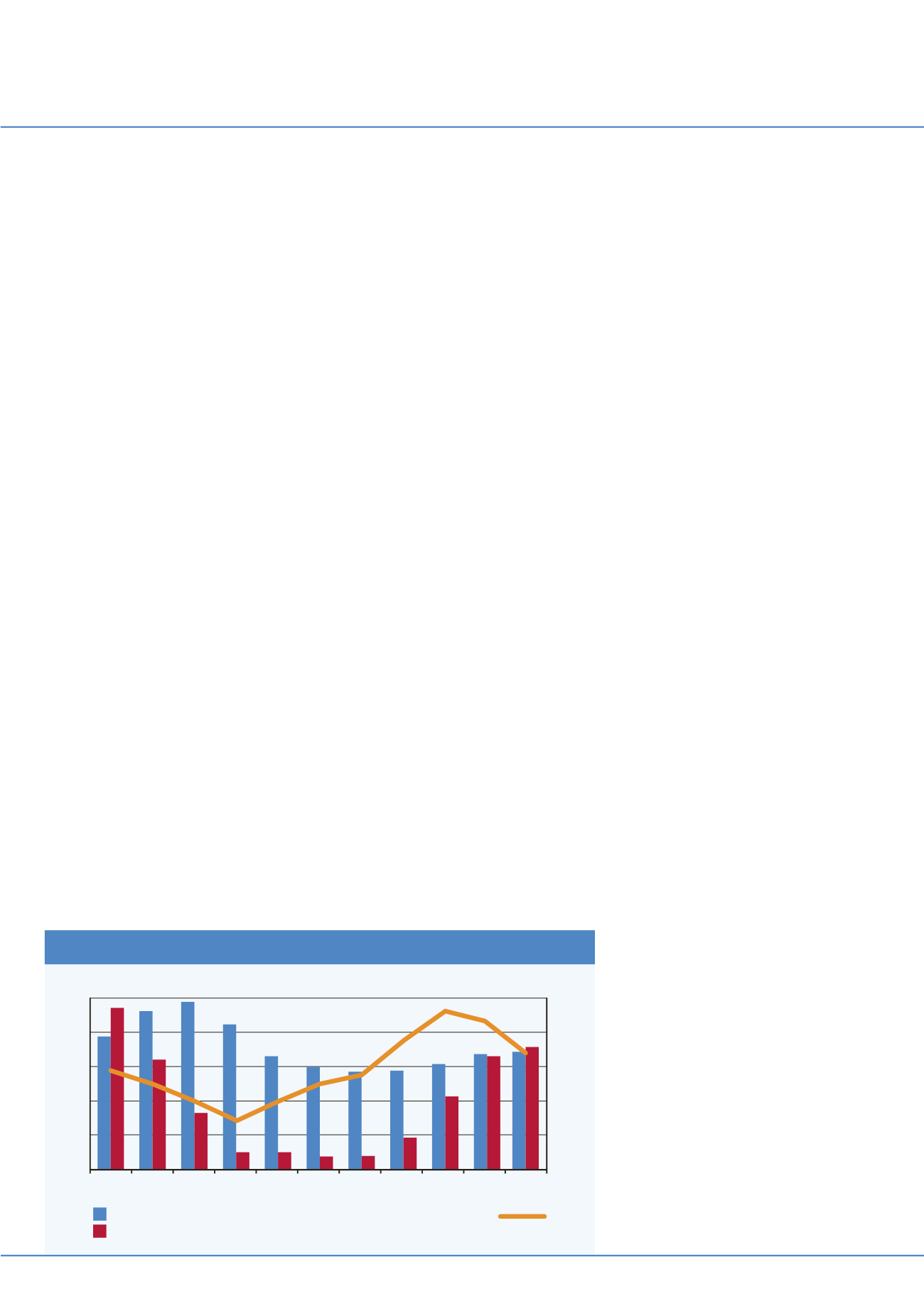
>
17
september 2013
international
construction
ECONOMIC OUTLOOK
Back to growth
Back to growth
US construction is seeing a strong rebound, but the public sector remains a weak link.
Scott Hazelton
reports.
T
he US economy has grown at less than
+2% for the third consecutive quarter,
and many of the factors that will shape the
near term, such as the reduction of the Federal
Reserve’s bond purchases or the impact of the
federal government sequester, are not easy to
predict. Even so, fundamentals for solid growth
are in place for 2014 and 2015 - both consumer
and business spending have increased in spite of
these conditions and will continue to do so.
Arguably, the most important event in recent
months was the 10-year Treasury bond yield
rising from 2.0% in late May to about 2.9% at
the time of this writing. Near-term growth in
the housing sector has been affected by higher
mortgage rates as a result. However, a lean supply
of housing, positive builders’ sentiment, and
continued rising prices should help the long-
term recovery of the sector.
Perhaps the biggest near-term uncertainty for
financial markets is when the Fed starts winding
down its US$ 85 billion per month asset-
purchasing program (QE3). While Fed officials
are eager to end bond buying, labour market data
is mixed and inflation is still running below the
Fed’s +2% target.
A “tapering” is likely in December, but even
so, the Fed will continue to purchase bonds for
another couple of quarters and keep interest rates
low at least until unemployment reaches 6.5%,
probably in late 2015. As such, the impact on
economic growth will probably be imperceptible.
The other policy uncertainty centres around
federal government spending and the sequester.
While the impact of the sequester was far less
than what was anticipated at the beginning of
this year, the third-quarter of 2013 is also the end
of the federal government’s fiscal year, meaning
that there are likely to be more cuts before
September. Assuming that the sequester lasts
through the end of the calendar year, that implies
a drag on growth from government spending in
the second half of 2013.
Housing sector
The impact of Fed tapering is being felt in the
housing sector, and the recent 100-basis-point
(1 percentage point) jump in mortgage rates
will slow the recovery. Higher rates have already
caused a sharp drop in the demand for mortgage
credit.
Housing starts which had been rebounding in
the early part of this year, now hover just under
a 900,000-unit annual rate. But the recovery
in home sales and construction will ultimately
continue since inventories are lean and demand
for housing exceeds supply. Homebuilder
sentiment remains high, and housing affordability
is still historically favourable.
An analysis of the underlying demand for
housing also suggests a resumption of this
growth: new households forming (1.1 million
units per year by IHS Global Insight’s estimate),
replacement demand (250,000 units/year),
and second-home demand (50,000 units/year).
Home prices will continue to rise faster than
inflation until at least the end of 2014. While
housing starts will number just under 1 million
in 2013, the market will improve, supporting
1.2 million starts in 2014 and nearly 1.6 million
units in 2015 and 2016.
Fixed investment has been another bright spot
of late, with most gains coming from housing
and equipment and intellectual property (a new
category, largely software).
On the non-residential side, the construction
market continues to suffer from excess inventory,
weak demand and undisciplined fiscal policy.
While the outlook is improved, employment and
income growth are still lagging for this point in a
recovery and it will still take some time for excess
space to be absorbed.
Commercial construction
The outlook for commercial construction as a
whole is positive, although it is expected to be
muted over the next few quarters, as businesses
remain cautious with long-term investment
spending.
Spending growth has been more moderate
in 2013 than in 2012 with expected growth of
+6.9%. Commercial spending will get a boost in
2014 and 2015 as the residential sector continues
to surge, falling back to a more normal pattern of
growth afterwards.
Office construction growth has faltered as
employment gains have been moderate, and
focused on part-time workers as Obamacare
costs discourage full-time employees. Growth
in 2013 will be +8.7%, down from +12.8%
in 2012. Even 2014 will see a slow start, with
growth improving over the year. Even so, IHS
Global Insight does not see a return to peak
office construction spending until very late in
the forecast.
Lodging construction will grow +15.7% in
2013, the best of all the commercial categories.
Spending will still be about a third of the peak
The trend for residential and non-residential construction
600
520
440
360
280
200
20
10
0
-10
-20
-30
Billion 2005 dollars
Percentage change
2006 2007 2008 2009 2010 2011 2012 2013 2014
2016
2015
Residential
Non-residential
Total growth
Perhaps the biggest near-
term uncertainty for financial
markets is when the Fed starts
winding down its US$ 85 billion
per month asset-purchasing
program (QE3).


